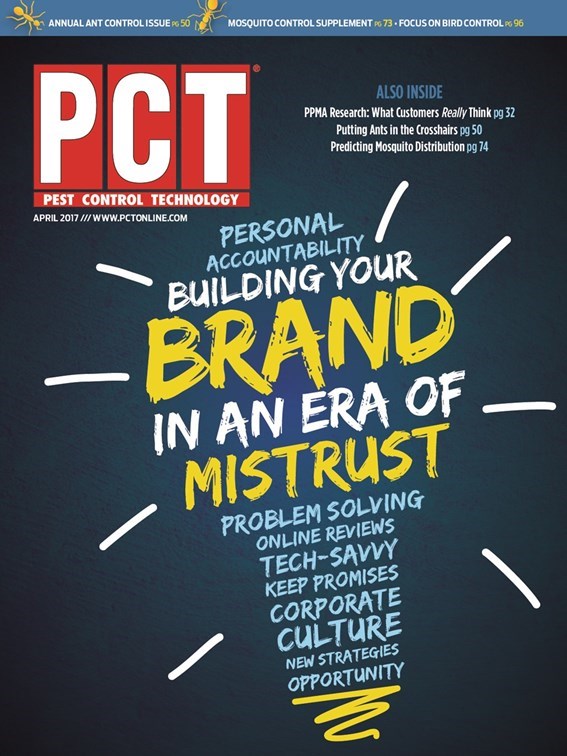
Protectors of public health. A decade ago, that description wouldn’t come to mind if you asked homeowners why they hired a pest control company. They’d talk about ants and termites, of course. And they might emphasize using referrals to find a provider — or looking online for a service provider instead of the Yellow Pages. But before now, pest control companies serving the common good as public health advocates was not a message circulating in the media or among consumers buying the service.
“We have seen the needle move,” said Cindy Mannes, executive director, Professional Pest Management Alliance (PPMA), which conducts a Consumer Attitudes Study every two years to measure what motivates Americans to use (and not use) pest control.
The 2016 study results indicated that people are indeed concerned about public health, and they see the pest control industry as a positive influence in this arena. In fact, 78 percent of respondents agreed that pest control professionals protect public health. Meanwhile, 80 percent agreed that the services protect their homes and properties.
“As an industry, we are moving in this direction and we do think that pest control companies could do more to promote themselves as protectors of public health and property,” Mannes says.
This message also aligns with NPMA’s new strategic focus and four tenants, one of which is that the industry be a major player in the public health arena, Mannes says. “We have changed the perception and been able to tell our own story instead of having other people tell that story for us,” she points out, adding that the research results reinforce the public’s evolving view of the industry. “We have changed the dialogue.”
What else has changed based on the 2016 study? Consumer demographics in today’s market is like never before. “It’s the first time in history we have four different generations,” Mannes says. “So, it’s important for pest control companies to know who they are talking to.”
INFORMATION GATHERING. The 2016 PPMA Consumer Attitudes Study included 2,027 interviews with adults age 25 and older who live in the United States and are homeowners with a household income of $60,000 or more. The survey was conducted between Sept. 1-8, 2016, by the third-party market research firm, Regina Corso Consulting.
Of the survey respondents, 46 percent were male and 54 percent were female. And, results showed that gender influences pest control buying decisions. Men were more likely than women to say professional pest control companies are more effective (77 vs. 61 percent); and men were more likely than women to say they purchase pest control to save money (30 vs. 23 percent). Forty-eight percent of women chose the service because they couldn’t tolerate pests.
With four generations in the marketplace buying services, we learned that attitudes can vary based on age. Homeowners age 25 to 44 were more likely to think positively of pest control than those 45 to 64, and 65-plus. (Those two groups were neutral.) And, more than four out of five homeowners age 25 to 44 said pest control companies are more effective in handling pest problems (than DIY) compared to three in five for those 45 to 64, and the 65+ plus population.
The regional breakdown of respondents represented an equal spread of consumers across the United States, and 47 percent lived in suburban environments.
WHAT’S BUGGING CONSUMERS? Speaking of public health, Zika swept national headlines in 2016 and for the first time mosquitoes ranked in the top four pests on homeowners’ radars. Forty-four percent of respondents said mosquitoes were the biggest threat, followed by rodents (42 percent). Overall, 3 in 10 were extremely concerned about pests causing illness to themselves or their families. Fifty-nine percent were concerned specifically about Zika.
“It was interesting and not surprising that mosquitoes made it (on the list) given everything that was on the news last year with Zika,” Mannes said. What also surprised Mannes was the fact that spiders ranked high as a “pest of concern,” following No. 1 ants. (Mosquitoes came in third, followed by rodents and finally cockroaches.)
In terms of pests the industry services on a regular basis, cockroaches certainly rank at the top, Mannes says. But consumers were more “bugged” by other pests.
Mannes emphasizes the importance of considering regional pest pressure and not relying solely on national data for marketing purposes. “If you are in the South, termites are still a huge concern,” Mannes added.

No matter the pest and what services a company provides, pest professionals should act as the experts and focus on educating consumers in their markets, Mannes says. “Even if you don’t do mosquito control, you can still be a resource for your customer,” she says, noting that PPMA provides materials that can be repurposed and distributed to consumers.
“Make sure the media knows to call your business if there is a pest issue,” Mannes adds. “Become the expert. That will help increase consumers’ understanding of what we do.
“People are responding positively to the industry because we can do so much to help them,” she said.
The author, a frequent contributor to PCT magazine, can be contacted at khampshire@gie.net.

Explore the April 2017 Issue
Check out more from this issue and find your next story to read.
Latest from Pest Control Technology
- SiteOne Hosts 2024 Women in Green Industry Conference
- Veseris Celebrates Grand Reopening of the Miami ProCenter
- Rollins' 2024 Second Quarters Revenues up 8.7 Percent YOY
- Fleetio Go Fleet Maintenance App Now Available in Spanish
- German Cockroach Control Mythbusting
- Total Pest Control Acquires Target Pest Control
- NPMA Workforce Development Shares Hiring Updates
- Certus Acquires Jarrod's Pest Control





